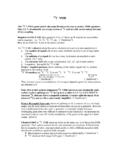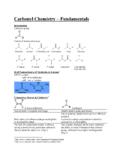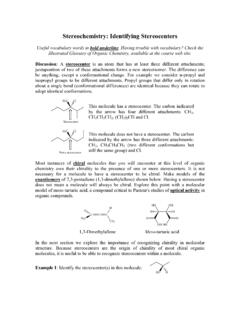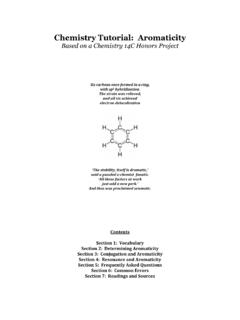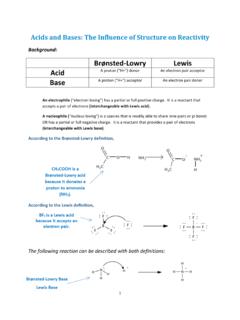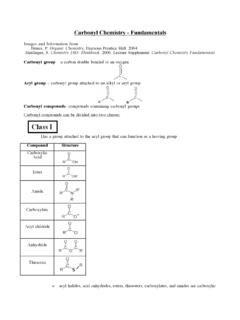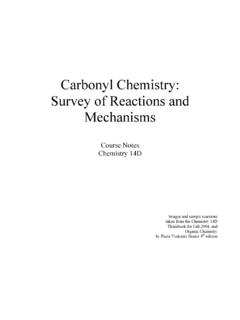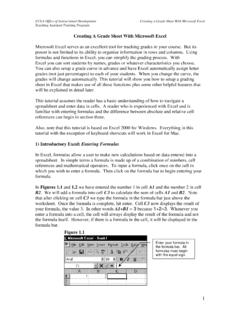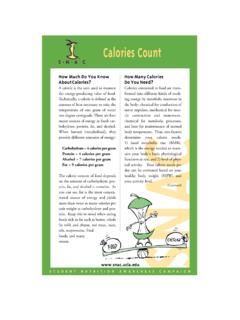Transcription of carbonyl fundamentals - UCLA
1 Table Note: Imines are not included in this tablehowever they have similar chemistry to aldehydesbecause the functional groups share manysimilarities. Both contain a pi bond between acarbon and heteroatom. In addition both canundergo the three fates: nucelophilic attach,electrophilic attach, and enolate Diagrams: fundamentals (All information and examples borrowed from Chem. 14D Thinkbook for Fall2006, Dr. Hardinger s Lecture Recordings and Paula Yurkanis Bruce sOrganic Chemistry 4th edition, unless otherwise indicated) carbonyl - the functional group is comprised of a carbon atomdouble-bonded to an oxygen atom (C=O). The various types ofcarbonyl containing functional groups are listed in the table on theright. Carbonyls can function as both a nucleophile and an electrophile. The polarity of the carbon-oxygen bond causes there to be apartial positive charge on the carbon atom and a partialnegative charge on the oxygen atom.
2 This electron-deficientcarbon atom acts as an electrophile. The carbonyl group can also act as a nucleophile. The oxygenof this functional group is electron rich because of its lonepairs and the pi bond. Nucleophilic attack on anothermolecule by the lone pairs on oxygen or by the pi bond givethe same result because the products are resonance structuresand thus identical. Three C=O Fates Accept nucleophile at carbon Occurs in ALL carbonyl addition mechanisms Produces tetrahedral adduct which occurs when thecarbonyl carbon goes from sp2 to sp3 hybridization. Depending on if there is a leaving group attached tothe carbonyl carbon there are two possibilities for theproduct of a nucleophilic attack on the Addition: no leaving group (LG) with aldehydes and ketones since alkenes and hydrogen are not LGs. The first step involves nucleophilic attack on the partially positive carbonatom to create the tetrahedral adduct resulting in an oxygen with a formalpositive charge.
3 The oxygen is then protonated to create an ,Secondary,Tertiary(shown)EnoneAcetylChl orideAceticAnhydrideDiagram Taken From: Nucleophilic carbonyl Substitution: LG is present. Occurs with ester, amide,anhydride, and acid chloride functional groups. Accept electrophile (usually H+) at oxygen There are two possible sites for nucleophilic attack of the carbonyl on an electrophile:the lone pairs and the pi bond. Is there a preference for the electrophile (usually H+) to be accepted by the lone pair orthe pi bond? No. Both sites are nucleophilic and both lead to the same product throughresonance. Form Enolate Assisted by resonance stabilization of conjugate base Initiated by a base deprotonating the carbon adjacent to the C=O carbon. How do we determine the rate of a C=O reaction?o The rate determining step (rds) is the slowest step of the reaction, the step with thehighest energy of activation.
4 This is the step that controls the rate of the In order to determine the rate determining step of the C=O, we must use Proton transfers are usually not the rate-determining step so we can ignore them forour Nucleophilic attack on the C=O is usually the RDS. What factors control the rate of nucleophilic attack on C=O? (in order of importance)1) Magnitude of + on the carbonyl carbon: A larger + makes the carbonyl groupmore electrophilic, nucelophilic attack will occur faster as a ) Resonance: Resonance can increase or decrease the + on the carbonyl may also be lost when the tetrahedral adduct is formed. Resonance addsextra stability to the molecule. As Dr. H put it, Resonance is like money. MoleculesDiagram Taken From: From: have it want to keep it and molecules that don t have it want to get it. Therefore, if resonance is lost the energy of the transition state is higher since themolecule is less stable.
5 This will make the molecule more resistant to nucleophilicattack. As a general rule, resonance between atoms in the same row of the periodictable is stronger than resonance between atoms that are in different ) Leaving group: The presence of a good leaving group controls whether addition orsubstitution occurs. (Study the mechanisms for addition and substitution to bettervisualize this concept).4) Steric effects: If there are large groups attached to the carbonyl carbon thenucleophile may be sterically hindered from attacking the carbonyl carbon and thusnucleophilic attack will be slowed because the carbon is blocked. What to think about when asked to identify the fastest reaction relative to otherreactions:o Look for differences between the reactions, considering similarities will not help inyour Analyze each of the four factors Examining nucleophilic addition and nucleophilic substitution in the various carbonylcontaining functional groups As mentioned before, the presence of a good leaving group determines ifnucleophilic addition or nucleophilic substitution will occur.
6 With that in mind, whenobserving the various carbonyl containing functional groups, aldehydes and ketoneswill undergo nucleophilic addition since alkenes and hydrogen are not good leavinggroups. By the same logic, thiolester (R-C-O-S-R), ester, amides, and carboxylateion (R-C-O-O-) can undergo nucleophilic substitution since they contain goodleaving groups. Nucelophilic addition reactivity for aldehydes vs. ketones Considering the four factors mentioned in the previous section:o We will consider the differences between aldehydes and ketones. Note thatneither have a leaving group and that resonance is the same. Therefore, thesetwo factors do not affect the relative reactivity of the functional group in + C=O: The + on the aldehyde carbonyl carbon is greater than that of theketone carbonyl carbon because the ketone contains two alkyl groups thatdonate electron density to the carbonyl carbon whereas the aldehyde only hasone alkyl group.
7 The more the magnitude of the + is reduced the moreresistant the carbonyl carbon is to nucleophilic attack. If the + is reduced, themolecule will be more stable initially and there will be less of a need to get ridof the partial positive charge. Conclusion: The rate of addition of aldehydes is faster than that Sterics: The ketone has two large alkyl groups attached to the carbonyl carbon,whereas the aldehyde only has one large alkyl group attached. Therefere, theketone has more steric hinderance which inhibits the nucleophile fromattacking the carbonyl carbon more than in the aldehyde case. As a result,ketones are less reactive than aldehydes. Nucleophilic substitution in thiolesters, esters, amides, and carboxylate ion. (Adaptedfrom Chem 14D Thinkbook CFQ #9, carbonyl Chemistry- fundamentals ) Considering the four factors that affect reaction rate:o carbonyl carbon + and Resonance: controlled by the magnitude ofresonance between the carbonyl carbon and its attachments.
8 We mustconsider the resonance lost as a result of substitution in addition to theaffects of resonance on the magnitude of the + on the carbonyl carbon(described above). The magnitude of resonance lost will affect the ratenucleophilic attack on the carbonyl carbon. Let s consider the resonance ofeach function group in question individually. Thiolester: Resonance is between carbon and sulfur. Resonance isbest between atoms in the same row of the periodic table. This is notthe case here as carbon is in the second row and sulfur is in the thirdrow. Ester: Resonance between carbon and oxygen. Stronger resonancebecause carbon and oxygen are within the same row of the periodictable. Amide: Better resonance than ester case because C and N are on thesame row of the periodic table and N is less electronegative than O,meaning it is more willing to share its lone pair electrons.
9 Carboxylate ion: Resonance with a negative oxygen in thecarboxylate case results in much more significant resonancecontributors than with neutral nitrogen in the amide case. Thus we conclude based on carbonyl carbon + and resonance thatthe order of increasing resonance stabilization is thiolester < ester <amide < carboxylate Steric effects: Difficult to determine. SR, OR, and NR2 are larger than O-,however it is difficult to distinguish between the others. Overall, resonanceROHRORD iagram From: Conclusion: In order of nucelophilic carbonyl substitution reactivity:thiolester > ester > amide > carboxylate a more crucial role in determining the rate of nucleophilic attack. In thisanalysis, steric effects can be ignored because its effect on the reaction rate Leaving group: Thiolester: SR is a good leaving group because of its high polarizability Ester: -OR is a poorer leaving group than SR because it is lesspolarizable than S, however, its higher electronegativity makes it a betterleaving group than NH2.
10 Amide: -NH2 a poorer leaving group than OR because N is lesselectronegative and less willing to accept electrons. Carboylate: -O2 is a horrible leaving group. It has a formal charge of 2-and low polarizability. Recognizing Mechanism PatternsThe flowchart below can help you recognize the mechanistic patterns present in carbonyl chemistryand help you logically reason out what comes next when thinking about mechanisms.(This flowchart was derived from OWLS-Survey of carbonyl Reactions and Mechanisms Problem #1)*Note: At every tetrahedral intermediate step (5), you should ask yourself Is there a leavinggroup? in order to know if nucleophilic carbonyl substitution or nucleophilic carbonyl addition C=O2. Nucleophilicattack at carbonylcarbon3. Protonate carbonyloxygen4. Enolate formation5. TetrahedralIntermediate8. Eject a LeavingGroup9. O acts as anucleophile6.
